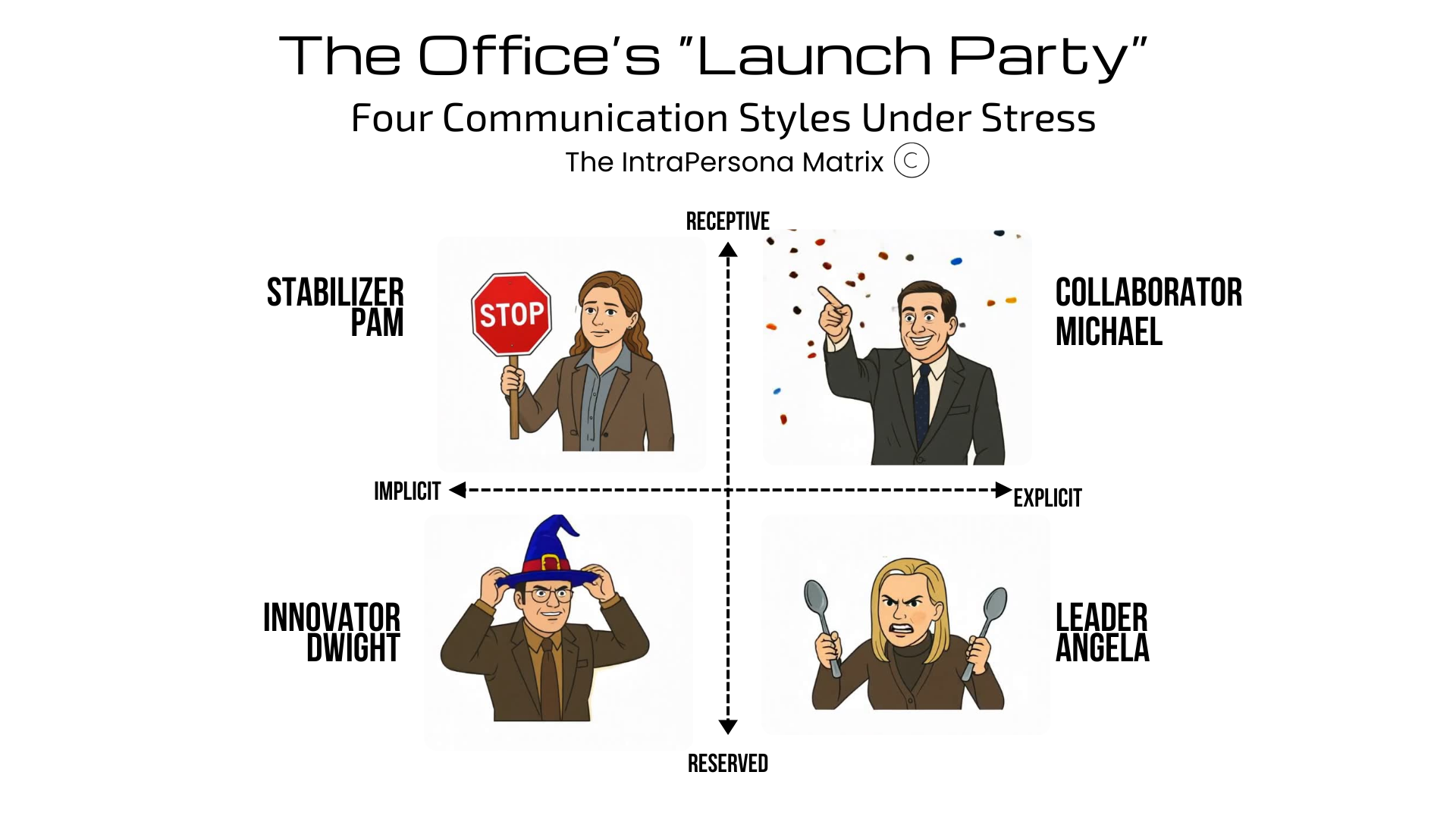The Office’s “Launch Party”: What It Teaches Us About Stress, Change, and Miscommunication

In Season 4, Episodes 5 & 6 of The Office, Dunder Mifflin rolled out its new online sales platform, Infinity. The Scranton branch was invited to join a virtual launch event. But in true Office fashion, what should have been a simple live stream spiraled into a case study of stress, miscommunication, and clashing personalities.
Viewed through the IntraPersona Matrix, the four communication styles—Leader, Collaborator, Stabilizer, and Innovator—show distinct ways of responding under pressure. Each style emerges from a unique blend of two dimensions: Explicit vs. Implicit expression and Reserved vs. Receptive engagement.

Pam – The Stabilizer (Implicit + Receptive)
Pam steps in when Jim attempts to prank Dwight during his “battle” with the website:
“Be nice. He’s going through a breakup.”
- How she handled stress: As a Stabilizer, Pam responded with quiet compassion. Rather than escalating the tension, she sought to ease it.
- Style perspective: Stabilizers prefer harmony and predictability. Under stress, they avoid drama and often downplay conflict to protect group balance. Pam’s instinct was to shield Dwight’s dignity rather than laugh at him.
- Lesson: In teams, Stabilizers prevent minor tensions from exploding, but they may also suppress their own frustrations to keep the peace.

Michael – The Collaborator (Explicit + Receptive)
Michael misread the invitation and drove to New York, convinced he was attending a VIP event. When turned away, he protested:
“Well, the invitation says ‘VIPs only. Is this a way to treat VIPs?’”
- How he handled stress: Michael externalized his stress loudly and dramatically, turning the situation into a public plea for belonging.
- Style perspective: Collaborators thrive on energy, connection, and recognition. Under stress, they exaggerate feelings of exclusion, equating “being left out” with “being devalued.” Michael’s reaction wasn’t about logistics—it was about identity and inclusion.
- Lesson: In organizations, Collaborators can rally morale, but under stress, they need guidance to focus their energy on constructive inclusion rather than dramatic protest.

Dwight – The Innovator (Implicit + Reserved)
Dwight waged war against the website itself, declaring:
“I can make more sales than a computer.”
- How he handled stress: Dwight retreated into eccentric logic, challenging the system head-on in a way that was bold but impractical.
- Style perspective: Innovators value independence and unconventional thinking. Under stress, they double down on unusual ideas, sometimes veering into extremes. For Dwight, competing with a machine became his way to prove relevance.
- Lesson: Innovators can drive change with fresh solutions, but during stress they need structure and boundaries to keep their creativity useful rather than chaotic.

Angela – The Leader (Explicit + Reserved)
Angela turned her sharp eye toward the party logistics, critiquing details like cutlery:
“I asked for assorted cutlery. These spoons are worthless.”
- How she handled stress: Angela narrowed in on order and control, using criticism to reassert authority in the chaos.
- Style perspective: Leaders thrive on structure and clarity. Under stress, they can become rigid enforcers of standards, focusing on flaws rather than flexibility. Angela’s fixation on spoons reflected her need to reestablish order when things felt out of control.
- Lesson: Leaders provide direction in times of change, but they must be reminded to balance rules with adaptability to keep teams moving forward.
✨ Each character demonstrated how their style—Explicit/Implicit, Reserved/Receptive—shaped their stress response. By recognizing these patterns, organizations can anticipate stress behaviors and redirect them back into strengths.
To book a session with individiuals or teams using the IntraPersona Matrix, click the link below!
